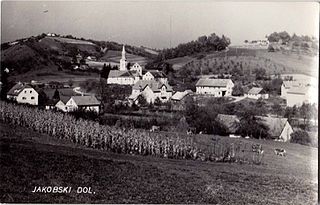| Ložane | |
|---|---|
| Coordinates: 46°34′16.91″N15°44′14.96″E / 46.5713639°N 15.7374889°E Coordinates: 46°34′16.91″N15°44′14.96″E / 46.5713639°N 15.7374889°E | |
| Country | |
| Traditional region | Styria |
| Statistical region | Drava |
| Municipality | Pesnica |
| Area | |
| • Total | 2.07 km2 (0.80 sq mi) |
| Elevation | 248.8 m (816.3 ft) |
| Population (2002) | |
| • Total | 89 |
| [1] | |
Ložane (pronounced [ˈloːʒanɛ] ) is a settlement in the Municipality of Pesnica in northeastern Slovenia. It is part of the traditional region of Styria. The entire municipality is now included in the Drava Statistical Region. [2]

A municipality is usually a single administrative division having corporate status and powers of self-government or jurisdiction as granted by national and regional laws to which it is subordinate. It is to be distinguished (usually) from the county, which may encompass rural territory or numerous small communities such as towns, villages and hamlets.

The Municipality of Pesnica is a municipality in northeastern Slovenia. The center of the municipality is Pesnica pri Mariboru, a suburb near Maribor. It lies at the western end of the Slovene Hills in the Upper Pesnica Valley. The area was part of the traditional region of Styria. It is now included in the Drava Statistical Region as part of the Pesnica Administrative Unit. The main economic activities in the area are tourism, transportation, viticulture, vinemaking, craftsmanship and farming.

Slovenia, officially the Republic of Slovenia, is a sovereign state located in southern Central Europe at a crossroads of important European cultural and trade routes. It is bordered by Italy to the west, Austria to the north, Hungary to the northeast, Croatia to the southeast, and the Adriatic Sea to the southwest. It covers 20,273 square kilometers (7,827 sq mi) and has a population of 2.07 million. One of the successor states of the former Yugoslavia, Slovenia is a parliamentary republic and a member of the United Nations, of the European Union, and of NATO. The capital and largest city is Ljubljana.
Four intact Roman-period burial mounds have been identified near the settlement. [3]

In historiography, ancient Rome is Roman civilization from the founding of the Italian city of Rome in the 8th century BC to the collapse of the Western Roman Empire in the 5th century AD, encompassing the Roman Kingdom, Roman Republic and Roman Empire until the fall of the western empire. The civilization began as an Italic settlement in the Italian Peninsula, conventionally founded in 753 BC, that grew into the city of Rome and which subsequently gave its name to the empire over which it ruled and to the widespread civilisation the empire developed. The Roman Empire expanded to become one of the largest empires in the ancient world, though still ruled from the city, with an estimated 50 to 90 million inhabitants and covering 5.0 million square kilometres at its height in AD 117.

A tumulus is a mound of earth and stones raised over a grave or graves. Tumuli are also known as barrows, burial mounds or kurgans, and may be found throughout much of the world. A cairn, which is a mound of stones built for various purposes, may also originally have been a tumulus.



